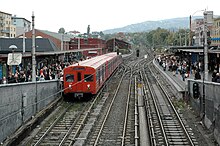Oslo Sporveier
[2] The new company also decided that the permitted car width be 2.5 metres (8.2 ft), allowing wider suburban trams to run in the city streets.
During the 1930 Oslo Sporveier decided they needed more rolling stock, and cooperated with Strømmens Værksted to create the Goldfish-series.
Built with an aluminum chassis, they were quick and light, with a distinct streamline shape, making them look like a goldfish.
[2] A test for the Oslo trolleybus service was performed in 1939; the breakout of World War II induced strict fuel rationing making it profitable for Oslo Sporveier to take into use trolleybuses using abundant electricity.
In December 1940 the first trolleybus route opened, line 17 from served as a shuttle for the tram at Rodeløkka.
Line 21 was the next to be converted—opening on 5 December 1943—running from Carl Berners Plass to Skillebekk, on route north of the city center.
[6] On 1 October 1944, Oslo Sporveier bought Bærumsbanen and took over the operation of the Lillaker-, Ekeberg- and Østensjø Line.
[8] On 15 September 1949, the Underground Railway Office (Tunnelbanekontoret) was established to start planning the Oslo Metro, a rapid transit system that would serve the new suburbs in Nordstrand and Groruddalen on the east side of town.
By 1960 the plans for the T-bane were in the works, and the city council decided to terminate all tram and trolleybus lines—replacing them with rapid transit and diesel buses.
[13] The first metro entered service on 22 May 1966 when the Lambertseter Line was converted and connected to the new tunnel leading to the Jernbanetorget Station.
The last closing of a tram line occurred on 24 June 1968 when the connection between Schewigaard Street and Etterstad was terminated.
[15] In 1977 the city council changed their decision to close down the tramway, mostly due to the 1973 oil crisis.
However, leaks forced the station to close in 1983, and not until 1987 did it reopen, this time also as the terminus for the western trams.
The brand name Oslo Sporveier was discontinued on 1 January 2008 when Ruter was created as a merger between it and Stor-Oslo Lokaltrafikk—who was responsible for public transport in Akershus.



